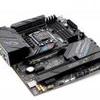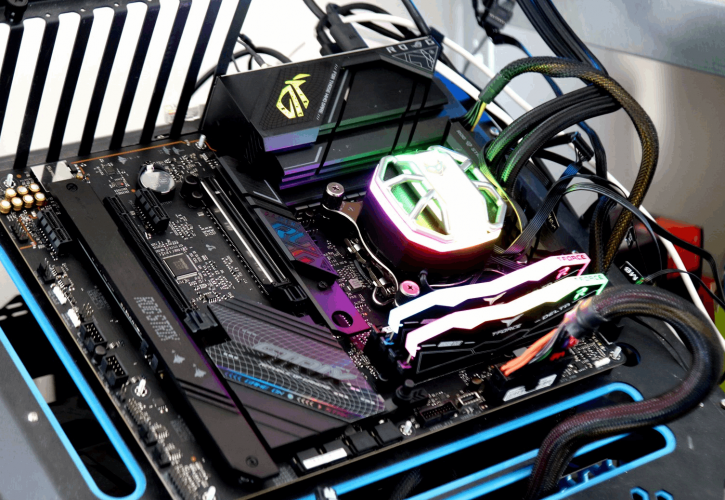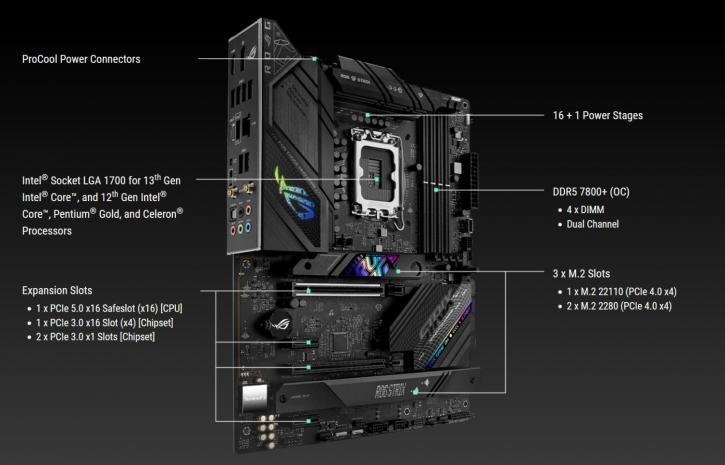Introduction
ASUS ROG STRIX B760 F-Gaming WIFI review
ASUS has just announced the release of the ROG STRIX B760 F-Gaming WIFI, a new motherboard designed for gamers and enthusiasts. The ROG STRIX B760 F-Gaming WIFI is built on the Intel B760 chipset and supports the latest 13th Gen Intel Core processors. It is an excellent choice for gamers and enthusiasts who want to build a high-performance PC for gaming and other demanding applications. One of the standout features of the ROG STRIX B760 F-Gaming WIFI is its support for high-speed memory. The motherboard supports DDR5 memory with speeds of up to 7800 MHz, which provides a significant performance boost for gaming and other memory-intensive applications. The ROG STRIX B760 F-Gaming WIFI also comes with a variety of features that are designed to enhance the gaming experience. It has a 2.5G Intel Ethernet port that provides fast and stable internet connection for online gaming and data transfers. It also has an Intel WiFi 6E AX201 module that provides fast and reliable wireless connectivity. Additionally, it has built-in Aura RGB lighting that allows users to customize the lighting on the motherboard to match their personal style. The ROG STRIX B760 F-Gaming WIFI also comes with a robust 17 virtual phase power delivery system that provides stable and efficient power to the CPU. The motherboard has a 16+1 power stage design that provides efficient power delivery to the CPU, ensuring that the system runs stable even when overclocked. The ROG STRIX B760 F-Gaming WIFI also has a variety of connectivity options that make it easy to connect peripherals and other devices. It has USB 3.2 Gen 2 ports as well as USB 2.0 ports. Additionally, it has a variety of audio and video outputs, including HDMI and DisplayPort, making it easy to connect to a variety of displays through the processors IGP. It is a pricey B series motherboard, though, as it costs $279.
| Cores | Cache | Clock Frequency /GHz | GPU | TDP | EUR | |||||||
| Core | Performance | Energy | L2 | L3 | Base P | Turbo P | Base E | Turbo E | Fashion model | Base | Turbo | Jan 2023 |
| i9-13900K | 8 | 16 | 32MB | 36MB | 3.0 | 5.8 | 2.2 | 4.3 | UHD 770 | 125W | 253W | 675 |
| i9-13900KF | 8 | 16 | 32MB | 36MB | 3.0 | 5.8 | 2.2 | 4.3 | 125W | 253W | 648 | |
| i9-13900 | 8 | 16 | 32MB | 36MB | 2.0 | 5.6 | 1.5 | 4.2 | UHD 770 | 65W | 219W | 630 |
| i9-13900F | 8 | 16 | 32MB | 36MB | 2.0 | 5.6 | 1.5 | 4.2 | 65W | 219W | 601 | |
| i7-13700K | 8 | 8 | 24MB | 30MB | 3.4 | 5.4 | 2.5 | 4.2 | UHD 770 | 125W | 253W | 469 |
| i7-13700KF | 8 | 8 | 24MB | 30MB | 3.4 | 5.4 | 2.5 | 4.2 | 125W | 253W | 440 | |
| i7-13700 | 8 | 8 | 24MB | 30MB | 2.1 | 5.2 | 1.5 | 4.1 | UHD 770 | 65W | 219W | 445 |
| i7-13700F | 8 | 8 | 24MB | 30MB | 2.1 | 5.2 | 1.5 | 4.1 | 65W | 219W | 415 | |
| i5-13600K | 6 | 8 | 20MB | 24MB | 3.5 | 5.1 | 2.6 | 3.9 | UHD 770 | 125W | 181W | 367 |
| i5-13600KF | 6 | 8 | 20MB | 24MB | 3.5 | 5.1 | 2.6 | 3.9 | 125W | 181W | ?338 | |
| i5-13600 | 6 | 8 | 11.5MB | 24MB | 2.7 | 5.0 | 2.0 | 3.7 | UHD 770 | 65W | 154W | 294 |
| i5-13500 | 6 | 8 | 11.5MB | 24MB | 2.5 | 4.8 | 1.8 | 3.5 | UHD 770 | 65W | 154W | 267 |
| i5-13400 | 6 | 4 | 9.5MB | 20MB | 2.5 | 4.6 | 1.8 | 3.3 | UHD 730 | 65W | 148W | 255 |
| i5-13400F | 6 | 4 | 9.5MB | 20MB | 2.5 | 4.6 | 1.8 | 3.3 | 65W | 148W | 225 | |
| i3-13100 | 4 | 0 | 5MB | 12MB | 3.4 | 4.5 | na | na | UHD 730 | 60W | 89W | 154 |
| i3-13100F | 4 | 0 | 5MB | 12MB | 3.4 | 4.5 | na | na | 58W | 89W | 125 | |
In terms of performance, the B760 chipset is capable of delivering solid performance for gaming and content creation. In benchmark tests, it is on par with the more expensive Z790 chipset in many games, and it can also handle demanding tasks such as video editing and 3D rendering. However, it should be noted that the B760 chipset does not support overclocking as well, mostly due to more restrictive VRM designs. Overall though, the B760 chipset is a solid addition to Intel's chipset lineup. It provides a balance of performance and features for mainstream and budget-conscious consumers. With that said, let's look closely at the platform and then head into testing.



